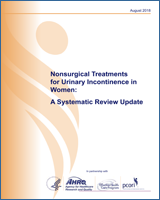| Population | Adult and elderly (as defined by authors) women with symptoms of UI (as defined by authors)
Subpopulations:
women athletes and those engaging in high-impact physical activities older women (whether “elderly” or just older than a younger analyzed subgroup, as defined by authors) women in the military or veterans racial and ethnic minorities
| If >10% of study participants are children or adolescents, men, pregnant women, institutionalized or hospitalized participants, have UI caused by neurological disease or dual fecal and urinary incontinence, dry overactive bladder syndrome (OAB), interstitial cystitis/painful bladder syndrome (or other pain syndromes).
In addition, if the percent of participants from any of these categories was not reported, we assumed that it is >10% and also excluded those studies. |
| Interventions | Nonpharmacological interventions: Health education about UI; behavioral therapy, including “lifestyle” interventions (e.g., dietary modifications, weight loss, fluid restriction), bladder training; biofeedback; pelvic floor muscle training and other physical therapy; vaginal cones/weights, bladder supports (e.g., Impressa®, therapeutic pessaries); electrical stimulation (e.g., posterior tibial nerve stimulation, sacral neuromodulation, intravaginal electrical stimulation); magnetic stimulation; urethral plugs and patches; urethral bulking, including transurethral or periurethral injections.
Pharmacological interventions: Estrogen preparations (topical estrogen); antimuscarinics (e.g., oxybutynin chloride, trospium chloride, darifenacin, solifenacin succinate, fesoterodine, tolterodine, propiverine); calcium channel blockers (e.g., nimodipine); Onabotulinum toxin A injections; TRPV1 antagonists (e.g., resiniferatoxin); antidepressants (e.g., tricyclics, SSRI, SNRI); beta-3 adeno-receptor agonists (e.g., mirabegron).
Combinations of eligible nonpharmacological and pharmacological interventions.
All doses or variations of interventions are included, including unapproved doses. Similarly, all eligible interventions are included regardless of regulatory body approval. | Interventions not available in the United States and surgical treatments |
| Comparators | Other eligible nonpharmacological interventions, other eligible pharmacological interventions, other eligible combination interventions, no active treatment or placebo. | Noneligible interventions, including surgery |
| Outcomes | Categorical measures of UI: “Cure”, improvement, and satisfaction. Cure indicates complete resolution of symptoms, as defined by authors; it does not imply permanent resolution requiring no further treatment. Improvement and satisfaction also were defined by study authors. We included outcomes that used pad tests and other measures of leakage volumes (categorized by a threshold); incontinence counts/frequency (e.g., by diary), including urgency UI counts/frequency and stress UI counts/frequency; physical examination (e.g., cough stress test); complete remission, improvement (partial remission), worsening, no change; subjective bladder control; patient satisfaction with intervention; need to use protection. Per the 2012 AHRQ report, only categorical measures of UI are included (e.g., an event [e.g., complete remission], a category [e.g., worse, same, better], above or below a threshold [e.g., ≤2 UI events/day].
Quality of life and related questionnaires: Generic, sexual function, UI-specific; validated.
Other patient-centered outcomes, based on the findings of the contextual question (what defines a successful outcome).
Adverse events. | Bladder and pelvic tests that do not measure UI specifically or are used for diagnostic purposes (e.g., urodynamic testing, pelvic muscle strength); urination measures that do not measure UI specifically (e.g., urinary frequency, total voids [which include nonincontinence voids], catheterization, postvoid residuals, urinary retention, perceived micturition difficulty) |
| Timing | Minimum 4 weeks followup (since the start of treatment) | |
| Settings | Interventions provided in primary care or specialized clinic or equivalent by any healthcare provider; participants are community-dwelling. | Surgical, institutionalized, or in-hospital settings |
| Country setting | Any geographic area | None |
| Study designs | For effectiveness outcomes (UI and quality of life):
randomized controlled trials (RCTs), with no minimum sample size, including pooled individual patient data from RCTs; nonrandomized comparative studies N≥50 women per group (N≥100 women total).
For harms outcomes:
RCTs, as above; nonrandomized comparative studies (regardless of strategies to reduce bias), including registries or large databases, N≥50 women per group (N≥100 women total); single arm longitudinal studies, including registries, large databases, and large case series N≥100 women; case-control studies (where cases are selected based on presence of harm), N≥50 female cases and ≥50 female controls (N≥100 women total).
For all outcomes: Published, peer-reviewed articles or unpublished data from the Food and Drug Administration (FDA) or from the Web site ClinicalTrials.gov. | For effectiveness outcomes: Single group, case-control, and case report/series studies; small nonrandomized comparative studies. |
| Publication language | Any | Unable to read, translate, or retrieve. |
